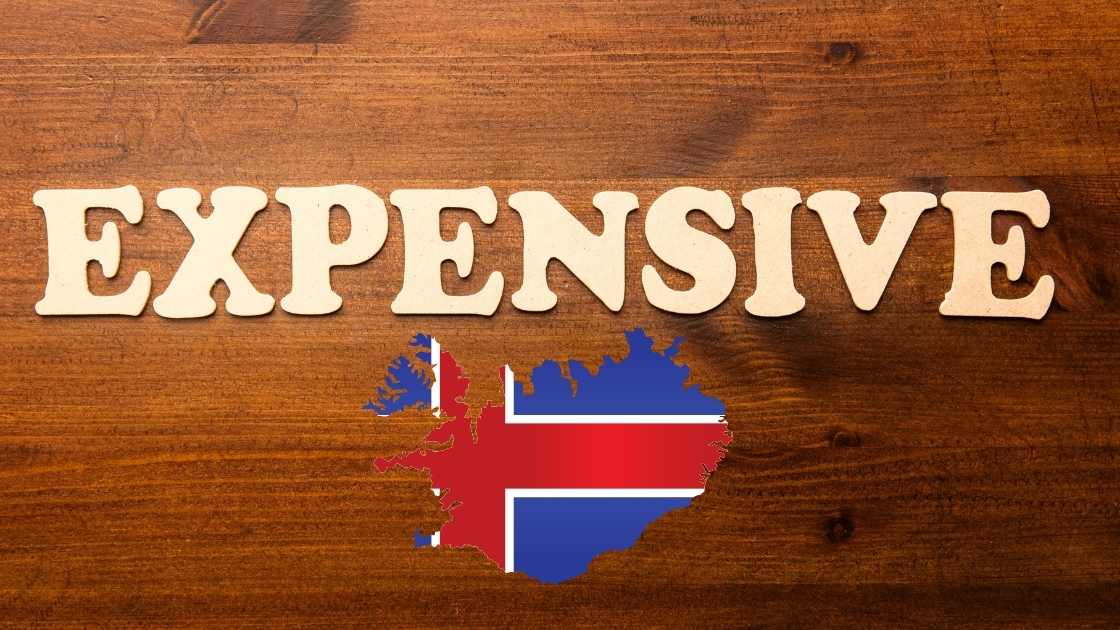

Whether you’ve visited Iceland before or you’re planning your dream trip, you’ve likely noticed that prices here are higher when compared to many other countries. From groceries and restaurants to accommodations and activities, Iceland’s cost of living and travel expenses can be a shock to the wallet. But why is that the case?
I’ll break down the key reasons behind Iceland’s high prices, including geographic isolation, the dominance of a few large companies, high taxes and import duties, a small population, and the impact of tourism.
Plus, I’ll be sharing details on my upcoming live webinar, “Iceland on a Budget: 30 Ways to Spend Less and Travel Smart,” where I’ll give you actionable tips to help you maximize your experience in Iceland without breaking the bank. Let’s get into it!
1. Geographic Isolation
Iceland’s remote location in the North Atlantic significantly impacts its economy. With no land connections to other countries, all goods must be transported by air or sea. This means higher shipping costs, which are passed on to consumers. Everyday essentials like food, clothing, and electronics come at a premium because of the logistics involved in getting them to the island.
For example, grocery stores like Bónus and Krónan import a large percentage of their products, leading to higher-than-average food prices compared to mainland Europe or the U.S. A simple item like a gallon of milk can cost around 900 ISK ($6.99 USD).
The cost of fuel is also steep and can be as high as 330 ISK ($2.33 USD) per liter or about $8.85 a gallon, partly due to import costs and high taxes. This geographic isolation extends to supply chains for restaurants and retail, where prices reflect these transportation challenges.
2. High Taxes and Import Duties
Iceland has some of the highest taxes in the world, and these contribute significantly to the high cost of goods and services. The standard Value Added Tax (VAT) rate is 24%, with a reduced rate of 11% on certain goods like food and books.
However, even with the reduced VAT, prices remain high. Import duties on certain items, such as clothing and electronics, add even more costs. For example, a pair of Levi’s jeans that might cost $60 in the U.S. can easily be $120 in Iceland due to taxes and import fees.
Cars are also heavily taxed, with import duties, VAT, and registration fees sometimes doubling the cost compared to other countries. This means that even everyday expenses like transportation, dining out, and shopping feel significantly more expensive.
3. Market Dominance by Few Companies
Iceland’s small economy means that a handful of companies dominate key industries, limiting competition and keeping prices high. The food retail sector, for instance, is primarily controlled by Hagar, which owns Bónus, Hagkaup, and other supermarkets.
This lack of competition can result in inflated grocery prices. Similarly, the telecommunications industry is led by Síminn, Nova, and Vodafone, all of which maintain relatively high service costs. The same goes for banking—Arion Bank, Íslandsbanki, and Landsbankinn dominate the financial sector, and their fees for everyday banking services can be steep compared to other countries.
The lack of competition in these critical industries means that consumers have limited options, and businesses have little incentive to lower prices. Even in tourism, major players like Icelandair control air travel, which can keep flight prices elevated, especially during peak seasons.
30 Budget Saving Tips for Iceland: Travel Smart and Spend Less
4. Small Population and Limited Market
With a population of about 370,000 people, Iceland has a tiny consumer base. This makes it difficult for businesses to achieve economies of scale, which would normally help lower prices. In many industries, goods are produced or imported in small quantities, leading to higher per-unit costs.
This issue affects everything from groceries to household goods. Additionally, because the market is small, international companies may find it unprofitable to operate here, further limiting competition. For example, while fast food chains like McDonald’s thrive in most countries, the franchise left Iceland in 2009 due to the high costs of operation after the economic crash in 2008. Many products that are considered everyday essentials in larger countries are treated as premium items in Iceland due to the cost of importing and distributing them.
5. High Wages and Inflation
Iceland has some of the highest wages in Europe, with average salaries well above those in many neighboring countries. While this supports a high standard of living, it also drives up labor costs for businesses.
Higher wages mean that everything from restaurant meals to hotel stays comes with a premium price tag. In addition, inflation has been a persistent issue, causing prices to rise even further.
Iceland’s labor market is also influenced by strong unions, which negotiate higher wages and benefits, further contributing to increased costs for goods and services. Over time, these factors compound to make Iceland an expensive place to live and visit.
6. Tourism’s Impact on Housing and Services
The boom in Icelandic tourism over the past decade has led to an increase in prices for housing, accommodations, and services. The rise of Airbnb rentals has had a significant impact, as many property owners choose to rent to tourists rather than long-term tenants.
This has driven up housing prices and made it difficult for locals to find affordable accommodations. For example, the average rent for a one-bedroom apartment in downtown Reykjavik can be upwards of 250,000 ISK ($1,750 USD) per month.
Beyond housing, the demand from tourists has also pushed up prices for restaurants, excursions, and even groceries, as businesses cater more to visitors than to locals. The cost of a simple meal at a casual restaurant can easily exceed 3,500 ISK ($25 USD), and a cup of coffee might be 800 ISK ($6 USD).
While tourism has been a major economic driver, it has also contributed to inflation and the rising cost of living in Iceland.
7. Limited Domestic Production
Iceland’s harsh climate and small land area limit agricultural and industrial production. As a result, the country relies heavily on imports for food and essential goods. This reliance increases costs, especially when global supply chain disruptions occur.
Locally produced food, such as dairy and lamb, can be costly due to the high costs of farming in Iceland’s challenging environment. The need for imports means Icelandic consumers pay premium prices for even basic necessities.
Iceland is undoubtedly an expensive place to live and visit, but understanding the reasons behind these high costs can help you plan better and make more informed decisions.
If you want to learn how to experience Iceland without breaking the bank, don’t forget to sign up for my live webinar, Iceland on a Budget: 30 Ways to Spend Less and Travel Smart.
Random Fact of the Episode
For some good news, Iceland’s Central Bank lowered its key interest rate by 50 basis points to 8.0%, in line with market expectations, following a drop in inflation to 4.6% in January.
Underlying inflation reached its lowest level in three years, and policymakers indicated that further disinflation is expected in the coming months. Fingers crossed that decreases continue to happen.
Icelandic Word of the Episode
Dýr – expensive
Share this with a Friend
Let's Be Social
Þakka þér kærlega fyrir að hlusta og sjáumst fljótlega.